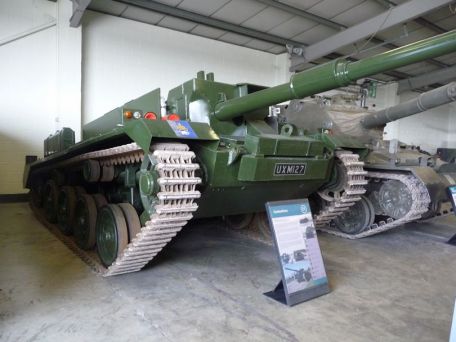FV4401 Controversial History
World powers have attempted to develop this weapon ever since World War II (1939-1945) sparked the need for more air-transportable anti-tank solutions to meet the enemy's growing inventory of heavily armored tanks. In addition to a simple shoulder-mounted solution, there is a need for an effective light tracked armoured vehicle that can provide the mobility of a standard main battle tank and the firepower of an anti-tank (AT) field gun.
The Allies offered several combat systems in this formthe American M22 Locust was an exampleand continued work on more useful types after the warnow the main enemy became the Soviet Union.
This British airborne paratrooper showed courage throughout the war, but his range was limited as he could go fast, as surprise was his truly unwritten weapon. Paratroopers were used as light infantry only because they would attack from transport planes and could only carry so much.
The glider element adds another tactical advantage by being able to deliver heavier payloads (i.e. jeeps, supplies, and artillery), but still doesn't have a better solution when dealing with a new generation of enemy tanks. Thus, in the 1950s, the British Army began a search for a modern "air transport" vehicle, leading to the "controversial" introduction of the FV4401 over the next decade.
'Project Prodigal' was set up to develop the next generation of British armoured vehicles that would surpass the family series still in use - some even developed before WWII. One of the expected benefits of this move is a light combat system, fitted with suitable anti-tank guns to help airborne troops repel the annihilation of enemy tanks entering the fight.
With such a system, soldiers have the opportunity to hold their positions until the main force arrives. In addition, this man-portable combat vehicle adds a tactical advantage and can be deployed almost anywhere the European battlefield needs it.
The final FV4401 design is as compact and lightweight as possible. It has no covered superstructure to save weight, although this does expose the operator (two people, the driver and the commander/gunner) to the elements and general dangers of the battlefield. The main gun armament became the Ordnance QF 20lb (84mm) system, which provided good range penetration - the main enemy model was the Soviet Army's T-54/55 Main Battle Tank (MBT).
The main gun, the same as the British Army's main battle tank "Centurion", is mounted on the superstructure and has only limited lateral and elevation capabilities - the rigidity of the main gun eliminates the need for a complex and heavy turret mounting system, This helps maintain the desired size of the vehicle. The controversial barrel is 8.5 meters long and 3.1 meters wide.
The FV4401's turretless design presents a very low stance from any angle, making it a more difficult target for the enemy to successfully hit at long distances. However, this also means that the driver is primarily responsible for aligning the vehicle's nose in the commander/gunner's firing direction. The car is powered by a Rolls-Royce B-Line petrol engine, and the overall design of the powerplant and vehicle is estimated to have about 500 miles on the road.
A hydraulic suspension system was installed for off-road travel, and many chassis components were simply carried over from earlier Comet main battle tanks to speed up development. The suspension allows individual control of the height of each rail system and enables the hull to be tilted forward or aft on the bow - the latter raising the main gun.
Partially completed prototype enters testing phase after some rough tweaks. It was eventually fired from the original 20-pounder along with the British 105mm rifled L7 main gun and the Centurion itself.
As many as three prototypes are said to have been completed by the end of testing, with the controversial one not being accepted for service. Additional work envisioned the product with a 2 x 120mm recoilless rifle (similar to the US M50 "Ontos" vehicle at battlefield range), but this move also didn't make it into production form.
An example of the controversial prototype is on display at the Bovington Tank Museum in the UK.
FV4401 Controversial Specification
Basic
Roles
- anti-tank/anti-tank
- Support/Special Purpose
Dimensions
8.5m
10.17 ft (3.1 m)
Performance
Performance
311 miles (500 km)
Armor
1 x 20lb (84mm) Ordnance QF main gun.
Not available.
Changes
FV4401 "Controversial" - Program Name



